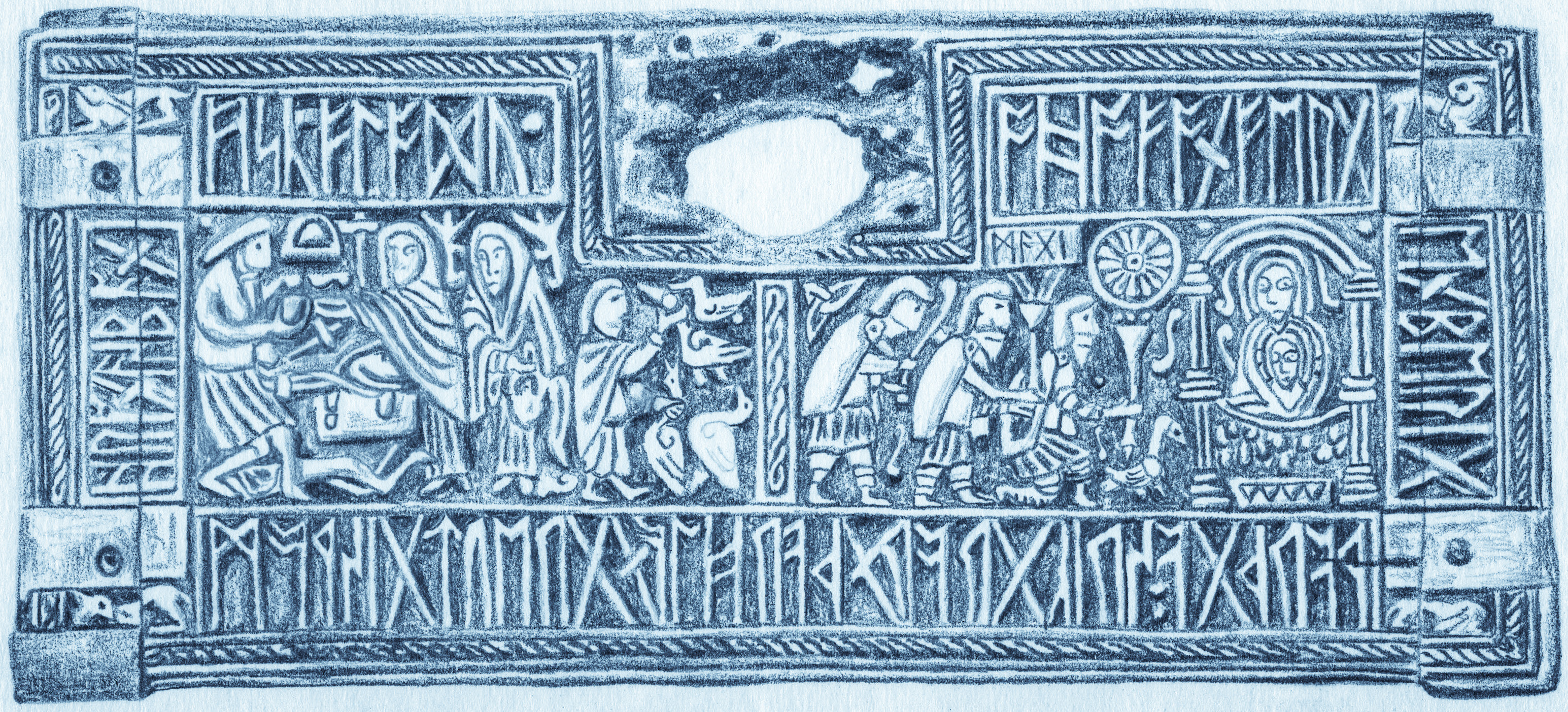Magic Metal Smiths

The Anglo-Saxon Franks Casket dates to roughly 700 CE. The front panel depicts the Adoration of the Magi on the right. Runes above the three men spell the word “Magi.” The star of Bethlehem is above them as they present their gifts to Jesus and the Virgin Mary. The left part of the panel is dedicated to the pre-Christian story of Wayland the Smith. With hammer and tongs, Wayland has crafted a cup from the skull of a prince, whose headless body rests at the smith’s feet. The princess Beadohild accepts a drugged drink from the cup. Wayland or his brother is killing geese to craft magic wings for an escape. The runic inscription around the border is a riddle. It reads, “Fisc flodu ahof on fergenberig. Warþ gasric grom þær he on greut giswom.” This translates, “The flood lifted up the fish onto the mountainous cliff. The king of terror became sad when he swam on the shingle.” The answer on the left side of the front panel reads, “hronæs ban” or “whale bone,” the material used to make the little box. The casket is an excellent example of the Anglo-Saxon use of runes as well as the ability of newly-converted European societies to place Christian images next to pagan myth.
The story of Wayland the Smith illustrates the vague nature of the boundaries between deity, elf, and hero, and between legend and myth. Wayland (also spelled Weyland and Weland) was a fantastic metal worker whose legendary exploits were told throughout pre-Christian Northern Europe. Unfortunately, most surviving references to him are fragmentary, but they serve as evidence of his widespread popularity and of the cohesive nature of his tale. His story is told most fully in the thirteenth-century poem from Iceland called the “Völundarkviða,” from which it is possible to make sense of the briefer references in other literature. There is ambiguity, however, in the Norse sources as to what Wayland, or in this case Völundr, was. One Scandinavian document refers to him as álfa lioði and vísi álfa, meaning prince or lord of the elves. Still, for the most part, the literature seems to regard him as a man in an extraordinary distant past.
The story of the smith begins with his capture by King Nithhad. To ensure that Wayland stays put, the king cuts the hero’s hamstrings. In revenge, the smith kills the king’s son and fashions a gilded goblet from his skull. He uses this to serve a drugged drink to Beadohild, the king’s daughter, whom he then rapes and impregnates. Wayland, with his extraordinary skill as a craftsman, fashions wings from the feathers of geese he has killed and flies away from imprisonment, leaving disaster in his wake as revenge for his ill treatment.
This story is reminiscent of the Greek legend of Daedalus, the extraordinary blacksmith whose exploits included imprisonment on Crete by King Minos. He escaped the island by crafting feathered wings for himself and Icarus, his son. The story of that tragic exploit is well known. Icarus flew too close to the sun, melting the wax that fastened the feathers, and the young man fell to the sea and drowned.
The name Daedalus means “bright” or “cunningly wrought” and there are several motifs that link the hero with Hephaestus, the divine smith of the Greek Pantheon. Robert Graves, an authority on Greek myth, suggested that “Hephaestus” means “he who shines by day.” The gods flung Hephaestus from Olympus, and he consequently hobbled as he walked. His Roman counterpart is the lame smith-god Vulcan, a name etymologically related to Wayland/Weland/Völundr. When combining and comparing the various motifs, it appears that there was a widespread story of a remarkable smith who angered a king, was imprisoned and mutilated so he could not walk fast. This hero then fled imprisonment, often by using his skill to craft magic wings.
The variants illustrate how easily a character of a popular story can slide between god, elf, and human hero. It is possible that the various oral traditions, spread over expanses of time and space, were self-contradictory. At the same time, it is important to remember that the authors who recorded these stories may or may not have been true to the oral traditions that they heard. It is simply not possible to sort out where the problem of diversity lies, or even if there is a problem. Oral traditions are notoriously amorphous and finding the definitive version of any story is an elusive goal. There is no “correct” account of a story; there are only numerous manifestations.